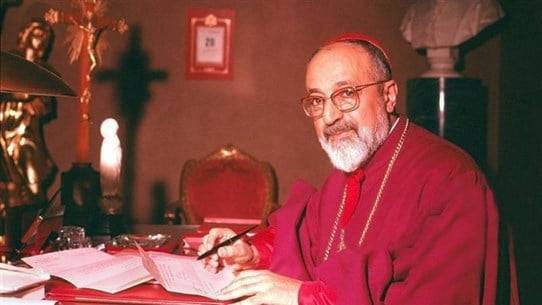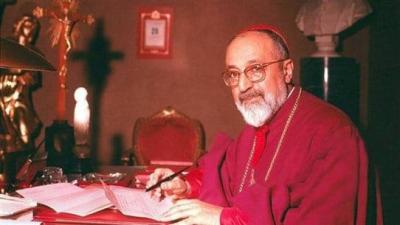Lebanon is about to welcome a new ray of light amidst the darkness and despair its people are experiencing these days. The land of holiness continues to bear the fruits of goodness, cultivating a story of rootedness in the land and belonging to both the homeland and God. In a magical "Jbeil," which has birthed saints and righteous figures who ascended spiritually in the paths of knowledge and faith, they have been the faithful guardians of Lebanon despite its suffering.
The awaited date will be Friday, October 28, in Rome, marking the beginning of the beatification and canonization process for Cardinal Gregorius Peter XV Aghajanyan (1895-1971), who served as the Catholicos and Patriarch of Cilicia for the Armenian Catholics.
The 28th was chosen for the opening session of the diocesan investigation into the life, virtues, sanctity, and miracles of Aghajanyan, as it coincides with the feast day of Saint Jude Thaddeus the Apostle, celebrated by Armenian churches as the "first Catholicos." The ceremony, representing the beginning of the beatification and canonization process for Cardinal Aghajanyan, will take place at noon in the Basilica of Saint John Lateran in Rome, in the presence of His Beatitude Patriarch Raphael Bedros XXI Minassian, Catholicos of Cilicia for Armenian Catholics, and Cardinal Angelo De Donatis, the Papal Vicar for the Diocese of Rome, representing the diocese where Cardinal Aghajanyan passed away and was buried in the church of "San Nicola da Tolentino."
Bishop George Asadorian, the Patriarchal Assistant and Bishop of Beirut for the Armenian Catholics, spoke to MTV about the life of the cardinal and his human and ecclesiastical journey, which will be central to the beatification process. He stated: "Friday, October 28, 2022, will be a historic day for the Armenian Catholic Church and also for Lebanon, as on this day the Vatican will announce the opening of the beatification cause for Cardinal Aghajanyan, who was nicknamed the Red Pope because he was the head of the Congregation for the Propagation of the Faith and one of the largest congregations in the Vatican during the 1950s. The cardinal was a very important and esteemed figure in the Catholic Church and among all Lebanese people."
His role extended beyond the church, as Asadorian noted: "He played a significant role in appointing the first Lebanese ambassador to the Vatican, President Charles Helou, who held this position before becoming president, and the cardinal personally recommended him for this role." More than that, the cardinal was a constant peacemaker among Lebanese leaders whenever they had disputes, gathering them regularly at the Armenian Catholic Monastery in Jounieh away from the spotlight to reconcile and mend their differences.
The cardinal was also an architect, added Asadorian, building within his community, particularly in Bourj Hammoud and creating St. Elias Church in the Dabbas square, which was generously constructed thanks to him in 1950, distinguished by its beauty and architecture inspired by Armenian heritage. Additionally, he constructed a church and school in Anjar.
His significant humanitarian aspect was evident in the role he played in establishing an orphanage in Anjar for displaced children and those who lost their parents. He raised Lebanon’s name on various platforms, including the Vatican, and was one of the four directors of the Second Vatican Council alongside the pope in 1962, being the first among them and presiding over the opening session and the initial meetings. He had a major role in the Catholic Church, traveling to many countries including the Philippines, China, Sri Lanka, Australia, Europe, and North and South America, establishing missions for both the Catholic Church and the Armenian Catholic Church, earning acceptance from all churches.
In a very significant moment, following the election of Pope John XXIII in 1958, he was the primary candidate but declined the position. The cardinal, originally from Georgia and aware of the struggles of the church there under the communist regime, worked diligently for the return of democracy to those nations, playing a vital role in Georgia and Armenia. However, Lebanon held a special place in his heart, as he had been the patriarch in Lebanon since 1938, teaching theology and philosophy in his early youth, and being appointed a bishop at a very young age of 32. He dedicated all his efforts to serve the Lebanese state and people because he loved them dearly and worked tirelessly for their comfort.
The cardinal, born in the city of Akhaltsikhe in Georgia, cherished both Georgia and Lebanon, for which he also held citizenship, advocating for it worldwide and always requesting states to support him in keeping Lebanon as "the Switzerland of the East."
Asadorian concluded: "We are proud of this cardinal and that he was Lebanese and held Lebanese citizenship, leaving a mark in his lifetime for Lebanon and Syria, as he played a significant role in returning the Kessab region and the mountains of Latakia to the Syrian state from Turkey after personally intervening with the French government." Just a few days separate Lebanon from this very important spiritual and national occasion, which may in the future gift it with a new saint.




